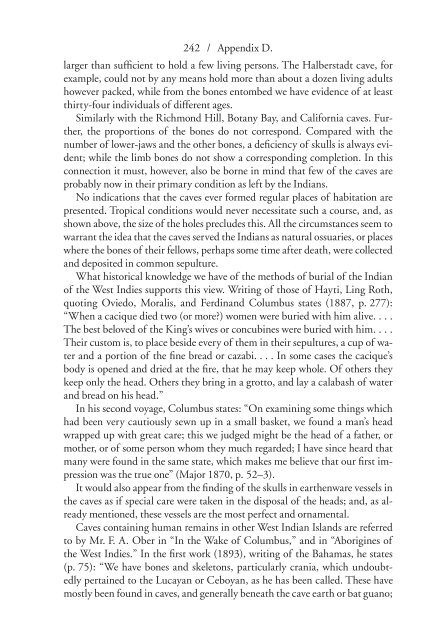Pre-Colombian Jamaica: Caribbean Archeology and Ethnohistory
by Phillip Allsworth-Jones
by Phillip Allsworth-Jones
You also want an ePaper? Increase the reach of your titles
YUMPU automatically turns print PDFs into web optimized ePapers that Google loves.
242 / Appendix D.<br />
larger than sufficient to hold a few living persons. The Halberstadt cave, for<br />
example, could not by any means hold more than about a dozen living adults<br />
however packed, while from the bones entombed we have evidence of at least<br />
thirty- four individuals of different ages.<br />
Similarly with the Richmond Hill, Botany Bay, <strong>and</strong> California caves. Further,<br />
the proportions of the bones do not correspond. Compared with the<br />
number of lower- jaws <strong>and</strong> the other bones, a deficiency of skulls is always evident;<br />
while the limb bones do not show a corresponding completion. In this<br />
connection it must, however, also be borne in mind that few of the caves are<br />
probably now in their primary condition as left by the Indians.<br />
No indications that the caves ever formed regular places of habitation are<br />
presented. Tropical conditions would never necessitate such a course, <strong>and</strong>, as<br />
shown above, the size of the holes precludes this. All the circumstances seem to<br />
warrant the idea that the caves served the Indians as natural ossuaries, or places<br />
where the bones of their fellows, perhaps some time after death, were collected<br />
<strong>and</strong> deposited in common sepulture.<br />
What historical knowledge we have of the methods of burial of the Indian<br />
of the West Indies supports this view. Writing of those of Hayti, Ling Roth,<br />
quoting Oviedo, Moralis, <strong>and</strong> Ferdin<strong>and</strong> Columbus states (1887, p. 277):<br />
“When a cacique died two (or more?) women were buried with him alive. . . .<br />
The best beloved of the King’s wives or concubines were buried with him. . . .<br />
Their custom is, to place beside every of them in their sepultures, a cup of water<br />
<strong>and</strong> a portion of the fine bread or cazabi. . . . In some cases the cacique’s<br />
body is opened <strong>and</strong> dried at the fire, that he may keep whole. Of others they<br />
keep only the head. Others they bring in a grotto, <strong>and</strong> lay a calabash of water<br />
<strong>and</strong> bread on his head.”<br />
In his second voyage, Columbus states: “On examining some things which<br />
had been very cautiously sewn up in a small basket, we found a man’s head<br />
wrapped up with great care; this we judged might be the head of a father, or<br />
mother, or of some person whom they much regarded; I have since heard that<br />
many were found in the same state, which makes me believe that our first impression<br />
was the true one” (Major 1870, p. 52–3).<br />
It would also appear from the finding of the skulls in earthenware vessels in<br />
the caves as if special care were taken in the disposal of the heads; <strong>and</strong>, as already<br />
mentioned, these vessels are the most perfect <strong>and</strong> ornamental.<br />
Caves containing human remains in other West Indian Isl<strong>and</strong>s are referred<br />
to by Mr. F. A. Ober in “In the Wake of Columbus,” <strong>and</strong> in “Aborigines of<br />
the West Indies.” In the first work (1893), writing of the Bahamas, he states<br />
(p. 75): “We have bones <strong>and</strong> skeletons, particularly crania, which undoubtedly<br />
pertained to the Lucayan or Ceboyan, as he has been called. These have<br />
mostly been found in caves, <strong>and</strong> generally beneath the cave earth or bat guano;


















